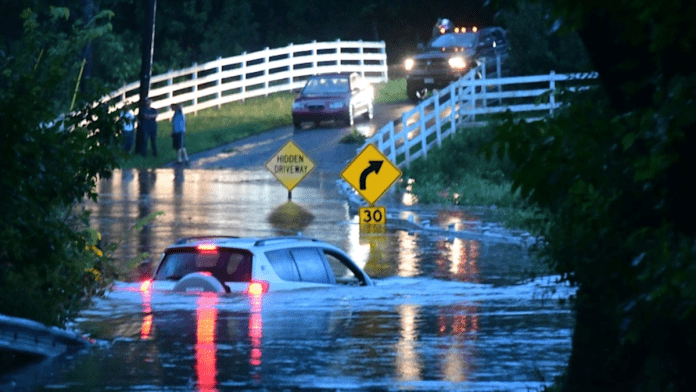🕒 Last updated on August 25, 2025
In Vietnam, tens of thousands of people are being evacuated as Typhoon Kajiki strikes the central coast. The storm, with winds reaching around 160 kilometers per hour, is expected to hit land on Monday afternoon.
Massive evacuations as central provinces brace for storm
Authorities have ordered more than 325,000 people across five coastal provinces to leave their homes. Many families are being taken to schools and public buildings, which have been turned into temporary shelters. Officials say these steps are vital to protect lives as the typhoon approaches.
In the city of Vinh, heavy rain already caused widespread flooding overnight. The streets were nearly deserted by morning. Most shops and restaurants had closed, and locals placed sandbags at their doorsteps to try to block the rising waters.
By dawn, nearly 30,000 people had already been evacuated from the region. Two domestic airports were closed, and all fishing boats in the path of the storm were ordered back to harbor.
The National Center for Hydro-Meteorological Forecasting said the typhoon is expected to make landfall around 1 p.m. local time with winds of about 157 kilometers per hour. However, forecasters also noted that the storm is likely to weaken quickly once it crosses the continental shelf of the Gulf of Tonkin.
Transport shutdowns and widespread disruptions
The incoming storm has caused major travel and business disruptions. More than a dozen domestic flights in Vietnam were canceled on Sunday, leaving thousands of passengers stranded. Train services in some areas were also delayed as officials worked to secure tracks from flooding and debris.
Meanwhile, China’s southern island of Hainan also faced the typhoon’s effects before it moved closer to Vietnam. Around 20,000 residents were evacuated there, and the main city of Sanya closed scenic areas and stopped most business operations.
In Vietnam, the Gulf of Tonkin has been hit by massive waves reaching nearly 10 meters. Officials warned fishermen and coastal communities not to go near the water. Rescue teams have been placed on high alert to respond quickly in case of emergencies.
People in the storm’s path are stocking up on food, water, and essential supplies. Schools in several provinces have suspended classes to ensure the safety of students and teachers. Many families have had to leave behind their belongings, not knowing what condition their homes will be in after the storm passes.
A year marked by deadly disasters
Vietnam has already experienced significant damage from natural disasters this year. In the first seven months of 2025, more than 100 people have been reported dead or missing due to floods, storms, and landslides. The agriculture ministry estimates economic losses during this period to be more than 21 million U.S. dollars.
The country also faced one of its most damaging storms in recent memory last September. Typhoon Yagi tore across northern Vietnam, leaving hundreds dead and causing losses estimated at 3.3 billion U.S. dollars. Many communities are still recovering from that disaster, making the arrival of Typhoon Kajiki even more concerning.
Scientists warn that storms in the region are becoming stronger and more unpredictable. Warmer seas and shifting weather patterns have been linked to climate change, which can make typhoons like Kajiki even more destructive. Vietnam, with its long coastline and low-lying areas, remains one of the most vulnerable countries in Asia to these extreme weather events.
As Typhoon Kajiki nears, life in coastal Vietnam has come to a standstill. From quiet streets in flood-hit Vinh to packed evacuation centers across the central belt, people are waiting anxiously for the storm to pass.

